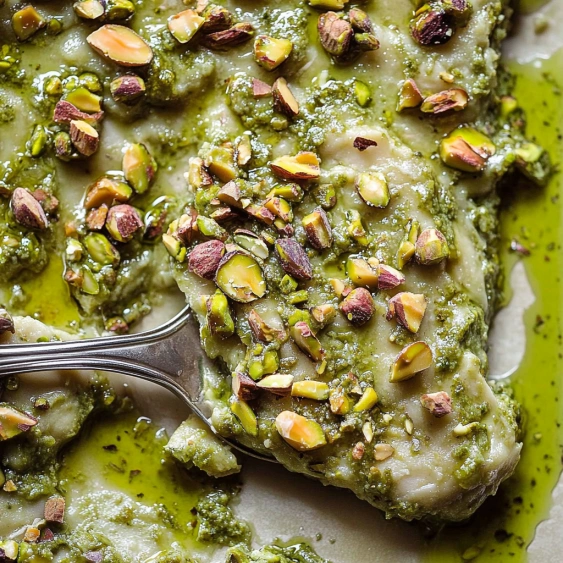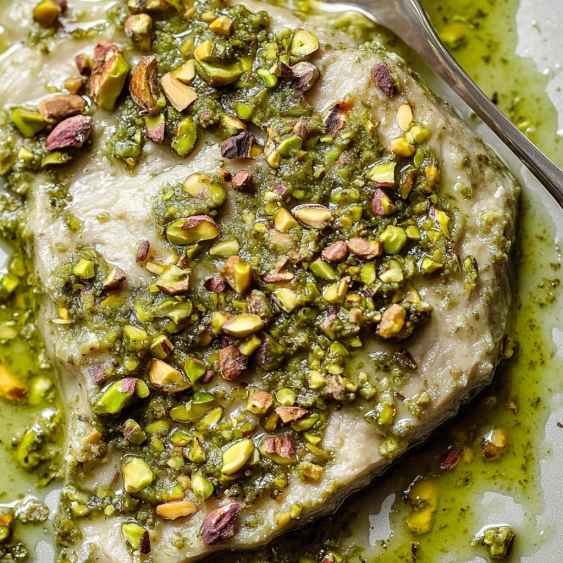 Pin it
Pin it
This luxurious pistachio aillade transforms any dish with its vibrant green color and complex flavors. The blend of toasted pistachios, garlic, and citrus creates a versatile sauce that elevates everything from grilled meats to roasted vegetables.
I discovered this aillade while traveling through southern France and have been making variations of it ever since. What began as a vacation souvenir has become my secret weapon for elevating weeknight dinners to something truly special.
Ingredients
- Shelled pistachios: Unsalted bring a buttery richness and beautiful green color to the sauce. Look for bright green nuts without blemishes for the best flavor.
- Garlic cloves: Form the aromatic foundation of this sauce. Select firm bulbs with tight skin and remove the green germ to prevent bitterness.
- Salt: Enhances all the flavors while helping to break down the garlic into a smooth paste. Flaky sea salt works beautifully here.
- Water: Helps achieve the right consistency without diluting flavor.
- Olive oil: Creates silky texture and richness. Choose a fruity extra virgin variety for the best results.
- Kirsch: Eau de vie or brandy adds sophisticated depth and helps marry the flavors together.
- Orange or tangerine zest: Brightens the sauce with citrus notes that balance the richness of the nuts and oil.
Step-by-Step Instructions
- Warm the Pistachios:
- Spread pistachios on a baking sheet and toast briefly in a 350°F oven for just 3 minutes. This gentle warming releases their oils and intensifies their flavor without risking any burning. Allow them to cool slightly before chopping to prevent them from becoming oily and difficult to work with.
- Create the Garlic Base:
- Pound garlic cloves with salt in a mortar and pestle until you achieve a smooth paste. The salt acts as an abrasive that helps break down the garlic cells. Work in a circular motion starting at the center and moving outward until no large pieces remain and the garlic becomes creamy and aromatic.
- Incorporate the Pistachios:
- Add chopped pistachios to the garlic paste and continue pounding until they break down into small consistent pieces. The natural oils will begin to release making the mixture slightly sticky. Be patient with this step as thorough crushing is essential for proper flavor development and texture.
- Build the Sauce:
- Add water first to create a base emulsion then slowly incorporate olive oil one tablespoon at a time while stirring continuously. This gradual addition ensures proper emulsification for a smooth cohesive sauce. Finish with a splash of spirits and fresh citrus zest grated directly into the mixture to capture the aromatic oils.
 Pin it
Pin it
The bright orange zest is my favorite ingredient in this recipe. The moment those citrus oils hit the pistachio mixture the entire kitchen fills with an incredible aroma that instantly transports me back to the sunny terraces of Provence where I first tasted something similar alongside a simple grilled fish.
Serving Suggestions
This vibrant aillade works beautifully as a finishing sauce for grilled meats especially lamb or chicken. The richness of the pistachios and brightness of the citrus cut through the savory proteins creating perfect balance. Try spreading a thin layer on crusty bread topped with goat cheese for an elevated appetizer or stirring a spoonful into plain yogurt for a quick dip with vegetables.
 Pin it
Pin it
Make It Ahead
The pistachio aillade will keep well in the refrigerator for up to five days stored in an airtight container with a thin layer of olive oil on top to prevent oxidation. The flavors actually improve after a day as they meld together making this an excellent make ahead option for entertaining. Allow it to come to room temperature before serving to fully appreciate the nuanced flavors.
Creative Variations
While traditional aillade uses almonds this pistachio version offers a more distinctive flavor profile. For interesting variations substitute hazelnuts for a portion of the pistachios or experiment with different citrus zests like Meyer lemon or pink grapefruit. Adding fresh herbs such as basil or mint just before serving creates another dimension of flavor that works beautifully in summer months when herbs are abundant.
Frequently Asked Questions
- → What can I serve with pistachio aillade?
Pistachio aillade is extremely versatile. Serve it with grilled or roasted meats (especially lamb), spread on crusty bread, dolloped on roasted vegetables, drizzled over pasta, or used as a dipping sauce for raw vegetables. It also works beautifully with fish or as part of a Mediterranean-inspired appetizer platter.
- → Can I make pistachio aillade in advance?
Yes! Pistachio aillade can be made 1-2 days ahead and stored in an airtight container in the refrigerator. The flavors actually improve as they meld together. Let it come to room temperature before serving and stir well, as some oil separation may occur.
- → What can I substitute for kirsch or brandy?
If you prefer to avoid alcohol, you can substitute a small amount of fresh orange or lemon juice for brightness. For alcohol alternatives, cognac, white wine, or even a splash of dry vermouth will work well in place of kirsch, eau-de-vie, or brandy.
- → Do I need a mortar and pestle to make aillade?
While a mortar and pestle produces the most authentic texture, you can use a small food processor instead. Pulse the garlic and salt first until paste-like, then add the warmed pistachios and pulse until coarsely chopped. Transfer to a bowl to stir in the remaining ingredients by hand for better control over the final consistency.
- → How long does pistachio aillade keep?
Properly stored in an airtight container in the refrigerator, pistachio aillade will keep for up to 5 days. The garlic flavor will intensify over time. A thin layer of olive oil on top can help preserve freshness. Discard if you notice any off smells or signs of spoilage.
- → Can I use roasted salted pistachios instead?
You can use roasted salted pistachios, but omit the added salt in the recipe initially. After combining all ingredients, taste and adjust the seasoning as needed. Be aware that commercially roasted nuts may have a different flavor profile than the home-warmed ones called for in the recipe.
